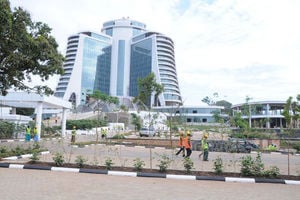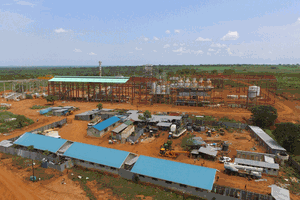
The Atiak sugar factory has received substantial government funding worth billions of shillings. PHOTO/FILE
The government has invested billions of shillings in several companies, but some are failing to yield returns. Increasing concerns are arising regarding the optimal approach to managing these investments efficiently.
Every fiscal year, these businesses and initiatives continue to deplete the state’s resources without yielding any tangible results.
From Atiak Sugar Factory, Dei Pharmaceuticals, Kiira Motors, the Presidential Banana Initiative, and the Lubowa Specialty Hospital, many have kept Ugandans guessing their strategic objectives.
Presidential Initiative on Banana Industrial Development
The state built a semi-automated plant in Bushenyi that can process 14 metric tonnes of fresh matooke daily. This project was meant to demonstrate the possibility of substituting wheat imports with highly sought-after gluten-free starch products on a worldwide scale.
However in 2023, government audit records show that the company only received 29.7 percent of the planned local revenue for the year that ended in June 2022.
The company “did not have an approved organizational structure and neither was evidence provided to confirm that the entity has an approved salary structure,” according to the Auditor General’s statement in the entity’s report published early this year.
“The entity [also] undertook procurements worth Shs0.49 billion using the wrong procurement method which was irregular.”
The state needs to re-evaluate its financing, according to development economist Fred Muhumuza, “because you do not want to bring in any economics but political reasons why it continues to get funded.”
For two decades, no open-sourced data shows that this project has yielded a tangible return but records show that it works with 6,543 farmers and has 150 employees.
Moses Kaggwa, the director of Economic Affairs for the Finance Ministry, says most of the cash the Treasury has been giving PIBID has been staked in the research stage.
“Now that the research stage has ended, we go into the commercialization stage, where we are going to make banana flour, produce vacuum packs, and make biscuits both for the commercial and international stage,” he told Prosper magazine.
Many economic observers view this ambitious venture as highly risky, noting its consistent financing without yielding tangible results.
Julius Mukunda, an economist says: “The government] has been giving the Presidential Banana Initiative money for the last 10 years. But they have not exported a single kilogram abroad. We only have a few samples that they put in supermarkets. You [need to] count their loss and close it” he said.
However, Finance Minister Matia Kasaija gives a leap of hope that the business has begun completing orders from overseas, such as those from Italy, South Korea, Qatar, and the Royal Kingdom of Saudi Arabia.
The government has given it an extra Shs50 billion to finish capitalization so that it can become a self-sustaining enterprise as it looks to start making profits.
Atiak sugar factory
Another firm that is embroiled in fumes of public anguish is the Atiak Sugar Factory, which is in Amuru district where the government now owns 40 percent of shares in this Horyal Investments Holding Company Limited subsidiary after increasing its stake in 2019.
The sugar manufacturer—whose ideal production capacity is estimated to be 66,000 metric tonnes—has received substantial government funding worth billions of shillings.
The company’s investment strategy drew the government in, as it did for numerous other projects but the business was already heavily indebted.
This forced it to restructure its debts through discussions that picked the interest of the government.
Through the Uganda Development Corporation (UDC), the government paid Shs20 billion in May 2018 for 10.1 percent of the shares, which would help finish Atiak’s factory. With the addition of Shs45 billion in July of the same year, the government’s share rose to 32 percent.
When Atiak requested an extra Shs24 billion to be used for staff housing and offices in April 2019, the government’s share increased to 40 percent.
But since then, Atiak has halted sugar production until July 2025, when it will be able to produce its sugarcane after modeling other sugar factories that rely on their sugarcane for efficiency.
It has already tested the downsides. Its out-growers farms burnt into flames as 2021 went to its close, destroying over 200 acres of sugarcane.
However, Mr Muhumuza thinks there is some financial discrepancy between the government and this company.
Other economists, like Mr Mukunda, argue that Uganda requires more sugar to stabilize and cut domestic prices; adding that businesses of this nature also provide employment opportunities.
Public Private Partnerships
The majority of these businesses are Public Private Partnerships (PPPs), which the government has funded to prevent the state’s budget from being overstretched by financing major economic initiatives when it can lower the associated costs by collaborating with suitable investors.
A formal PPP framework policy was adopted by Uganda in 2010 with the goals of improving public fund allocation and use, delivering infrastructure more effectively, offering high-quality public services, and spurring economic growth and foreign direct investment.
According to economist Richard Sempala, these partnerships work well when private-sector technology and innovation combine with public-sector incentives to complete work on time and within budget.
However, risks for private enterprises include cost overruns, technical defects, and an inability to meet quality standards.
“Whenever government allocates money and then these firms fail to take off, that is a cost to the entire economy, especially the taxpayers’ money,” says Mr Sempala.



